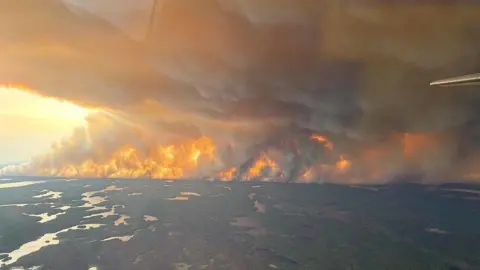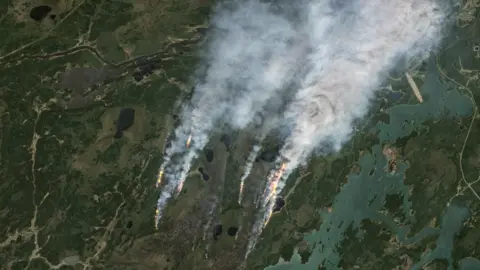Now Reading: More hot weather forecast as Canada battles fires and smoke billows south
-
01
More hot weather forecast as Canada battles fires and smoke billows south
More hot weather forecast as Canada battles fires and smoke billows south

Canadian officials are warning of tough days ahead for fighting growing wildfires in Saskatchewan and Manitoba with hot and dry weather in the weekend forecast.
The wildfires have forced thousands to evacuate in the two central prairie provinces, with both this week declaring states of emergency.
In Manitoba, the entire city of Flin Flon has been emptied, except for firefighters and support workers, as a large blaze threatens the community.
Smoke from the fires has triggered air quality alerts in Canada and as far as Chicago, where forecasters say the smell of smoke will be noticeable by Friday evening.
“It’s been another challenging day here in Manitoba,” the province’s premier, Wab Kinew, told the BBC.
Describing the effort to contain the wildfires, Kinew said firefighters were using “water bombers flying overhead” and “helicopters dropping buckets of water”.
“But at the same time, all the smoke in the air is making the evacuation effort that much more difficult,” Kinew said.
Thousands of “tired” and “stressed” displaced Canadians from north Manitoba are currently staying in shelters in the province’s capital city, Winnipeg, he added.
In Manitoba, there are a total of 22 fires burning, according to the province’s fire situation report, with four classified as out of control.
“Our provinces here in Canada are immense,” Kinew said. “By the time somebody makes it to Winnipeg, some of them have been on the road overnight. They’ve had to be on a flight for a few hours and then on a bus for several hours after that.”
 GOVERNMENT OF MANITOBA IN CANADA / HANDOUT
GOVERNMENT OF MANITOBA IN CANADA / HANDOUTThere are also air quality advisories in place in parts of the US Upper Midwest, including Michigan, Minnesota, and Wisconsin, affecting an estimated 22 million Americans.
“Conditions maybe unhealthy for sensitive groups and there is a possibility that hourly levels could reach the unhealthy range for a short period of time,” the state of Michigan said on Friday.
The advisories in Michigan and Wisconsin are currently in place until Saturday morning.
Residents in northern Minnesota have been warned smoke could reach levels “unhealthy for everyone”, with the rest of the state facing air quality that could effect those in sensitive groups. That alert runs through Monday evening.
There are 15 wildfires burning in Saskatchewan as of Friday, with the Canadian Interagency Forest Fire Centre (CIFFC) classifying conditions in the province as extreme.
Seven of those fires are not contained, according to data from the province.
Thousands of people from 16 communities had been forced to evacuate in Saskatchewan this week as a result of the fires.
Overnight, armed forces were also called in to help safely evacuate the northern First Nations community of Pukatawagan.
About 125 firefighters are coming up from the US to help battle the fires in Canada, along with other international crews.
Danielle Desjardins, a meteorologist with Environment and Climate Change Canada based in Winnipeg, told the BBC that the forecast for both provinces does not spell relief any time soon, with hot and dry conditions expected to continue into the weekend.
A cold front is expected to hit some parts of Saskatchewan, bringing with it some rain, but its current forecasted path narrowly misses the regions where the fires are burning.
“The bad news about this cold front is it’s going to be windy,” said Ms Desjardins, adding that the wind, coupled with the heat and lack of rain, are prime conditions for wildfire spread.
She said Saskatchewan has been “extremely dry” since March, and is experiencing abnormally warm weather for May that has pushed temperatures to above 30C (86F).
She added that anecdotally, “it’s one of the worst (wildfire seasons) in recent years for Saskatchewan”.
 Copernicus Sentinel-2/Reuters
Copernicus Sentinel-2/ReutersThere is also concern smoke from Canada’s fires could affect the G7, being held in mid-June in Alberta. Fires are currently burning in the northern part of the province.
There are currently seven fires considered “of note”, meaning they may pose a threat to people or infrastructure, out of 50 burning in the province.
Canada experienced its worst wildfire season on record in 2023, when over 42 million acres (17.3m hectares) burned – an area larger than all of England – and more than double the previous record.
Smoke from those wildfires blanketed cities south of Canada’s border into the US, including New York City.
But the 2023 fires were more acutely felt in Alberta, British Columbia, the Northwest Territories, Nova Scotia, Ontario and Quebec. This year, it is Saskatchewan and Manitoba that are seeing the largest fires to date.
Fires happen naturally in many parts of the world. It is difficult to know if climate change has caused or worsened a specific wildfire because other factors are also relevant, such as changes to the way land is used.
But climate change is making the weather conditions needed for wildfires to spread more likely, the IPCC, the UN’s climate body, says.




















































